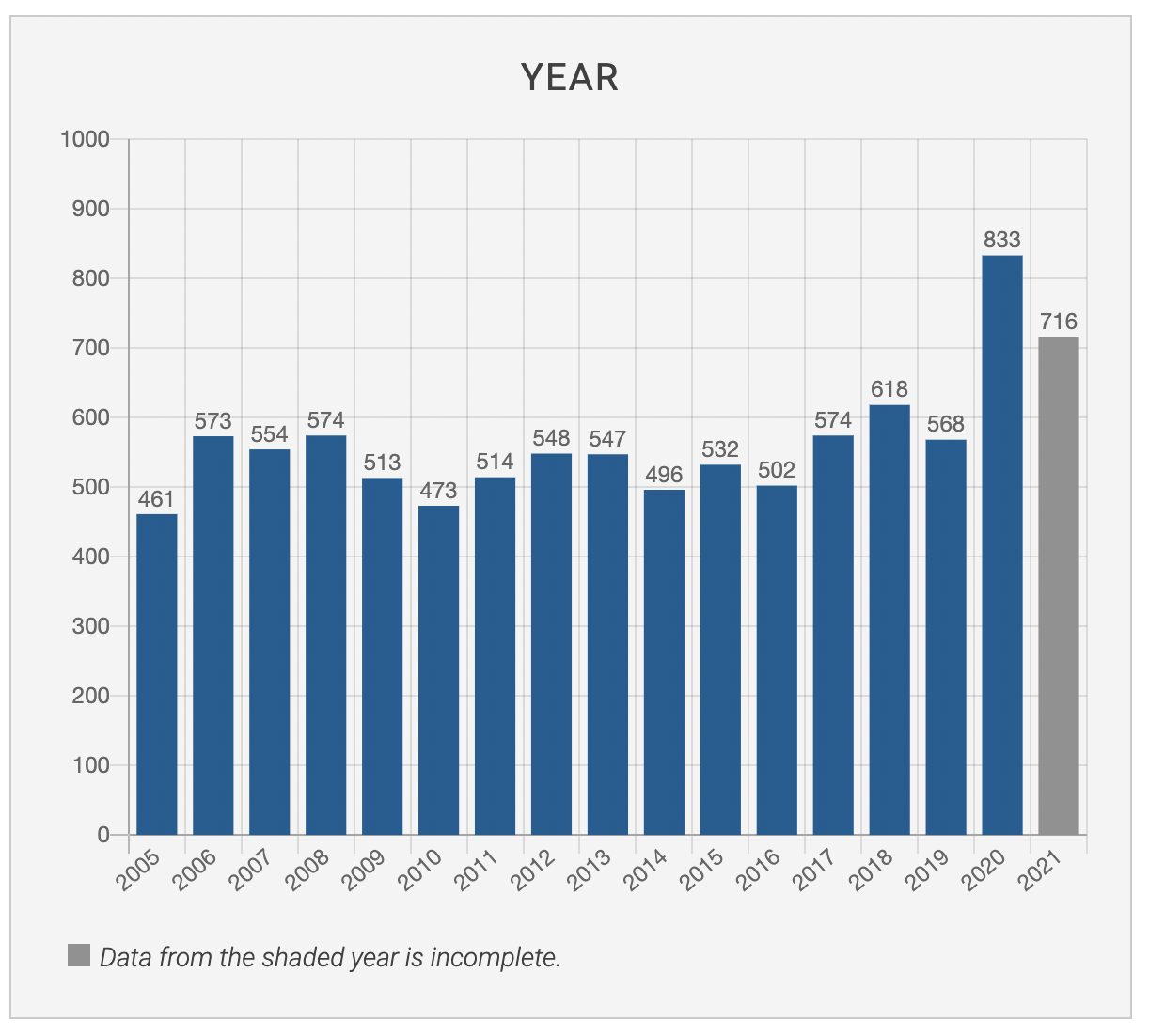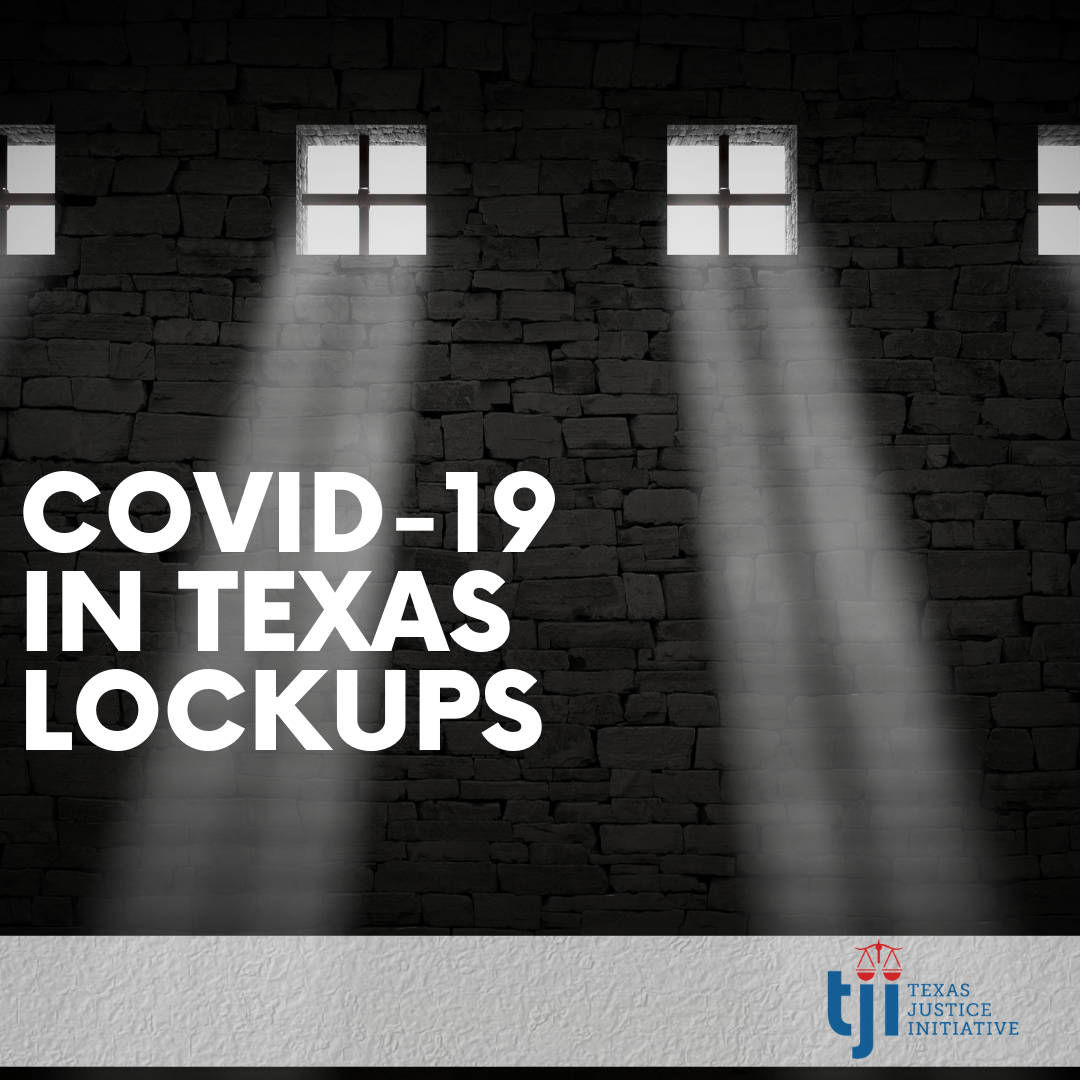TJI Blog
Where the TJI team posts blogs about our data, publications, analyses, and code.
2021 Deaths in Custody decline from previous year
May 24, 2022The good news*: the number of people who died in the custody of Texas law enforcement went down in 2021 after peaking the previous year.
The bad news: 2021's total — 906 deaths, according to reports filed with the state of Texas through May 1, 2022 — was still higher than every other year but 2020.
Deaths in custody of law enforcement, including anything from a deadly shooting by a law enforcement officer or an overdose in the back of a patrol car to a death by suicide or medical cause in a prison cell, must be reported to the state of Texas within 30 days of occurring. Based on those reports, which TJI tracks every month, there were an average of 677 Texas deaths in custody from 2010 to 2019. Then, due undoubtedly in part to the 2019 coronavirus, deaths in custody rose nearly 45% higher than the prior 10-year average before dropping slightly in 2021.
The leading manner of death in 2021 continues to be of causes deemed “natural,” though the percentage of deaths by natural causes was fewer than in 2020 and for 2010 - 2019. The percentages of deaths due to “other” causes and “accidental” causes were slightly higher in 2021 than in 2020 and for 2010 - 2019, while deaths due to “homicide” were slightly lower. As in previous years, the highest concentration of custodial deaths in Texas took place among individuals over the age of 60.
* Good/bad news labels based on assumption that reducing the number of deaths that occur in the custody of Texas law enforcement is a positive thing
COVID-19 drives spike in deaths in Texas prisons and jails in 2020
December 22, 2021
According to custodial death data, 2020 was the deadliest year on record for people who were incarcerated in Texas prisons and jails (see graph above). At least 830 individuals died in Texas prisons and jails, an increase of 46% over the previous year (2019), based on reports filed with the Texas Office of the Attorney General. This increase was largely driven by the coronavirus, which – agencies self-reported – killed at least 278 people in prisons and jails last year.
Broken out on its own, COVID-19 was the second-highest cause of death in jails and prisons, accounting for 34% of 2020 deaths, behind all other natural causes/illnesses at 50%. Excluding COVID-19 fatalities, deaths from natural causes in 2020 were consistent with previous years. Historically, natural causes account for more than three quarters of deaths in jails and prisons. Between prisons and jails, prisons saw both the highest number of deaths overall (84%) and the highest concentration (92%) of COVID-19 deaths. Among incarcerated individuals over the age of 50, COVID-19 accounted for at least 40% of deaths.
As the COVID-19 pandemic took hold in the U.S., there was a brief acknowledgement of the unsanitary and cramped conditions – which are also a breeding ground for the novel coronavirus – characteristic of U.S. detention centers. States across the country dramatically downsized their incarcerated population and granted compassionate release to those already infected with (or more likely to die from) COVID-19. However, in Texas, explicit policies to reduce populations during the pandemic were few and far between, according to the Prison Policy Initiative.
The data on conditions in Texas facilities was often inaccurate and unreliable. The tracking dashboard maintained by the Texas Department of Criminal Justice occasionally had disclaimers stating that the data was unreliable. TDCJ also published announcements when incarcerated individuals and employees died of COVID-19, but those posts have become sporadic at best. Additionally, agencies also took longer to file their custodial death reports, some showing up months after the 30-day deadline as required by state law. Lastly, changing, incomplete or vague reporting of the precise cause of death made it difficult for watchdogs, like TJI, to capture all COVID-related deaths in their reporting. For example, during the pandemic, TJI started tracking deaths that are reportedly caused by “bronchopneumonia,” a cause that didn’t exist much on reports before 2020.
Beyond being a tragic example of the deadliness of COVID-19, the spike in deaths within Texas jails and prisons in 2020 raises questions about the conditions that make those facilities uniquely vulnerable to outbreaks. The lack of disinfectants and poor medical care, in conjunction with cramped conditions and the negative impacts of living in a high stress environment, all contribute to making jails and prisons inherently unsafe and, in 2020, increasingly deadly spaces. Worst of all, this trend doesn’t seem to be slowing down: 2021 has already exceeded 2019 totals by 6%, with 600 deaths reported as of the end of October.
NOTE: For the purposes of this analysis, custodial death reports were cross-referenced against manually-gathered reports from media and other law enforcement sources to determine whether a death was due to COVID-19. Data was pulled in the first week of November 2021.
COVID-19 data scant during Delta variant wave
October 4, 2021For months, Texas has been battling the highly contagious Delta strain of the coronavirus. After a surge in the beginning of 2021, deaths due to COVID-19 were somewhat low in the spring – but then they started to climb.
And despite the rise in cases undoubtedly affecting individuals incarcerated in prisons and jails, who are particularly vulnerable to die from COVID-19, the actual reporting of infections and deaths in Texas lockups has mostly stopped.
For many months since the start of the pandemic, the Texas Commission on Jail Standards, which is responsible for ensuring county jails operate within state law, had asked jails to file daily reports on whether (and how many) infections were detected among staff and incarcerated individuals. However, that practice ended in June, when TCJS informed jails that the reports were no longer required.
Throughout the pandemic, the Texas Department of Criminal Justice, which oversees prisons, periodically announced deaths of employees and incarcerated individuals online. Yet no deaths of incarcerated individuals have been announced since mid-June.
Amid this dearth of data on COVID-19 deaths in Texas lockups, since mid-June, more than 13,400 Texans have died from the coronavirus, according to state data. Also since mid-June, the pandemic has killed at least 31 people who worked for county sheriff's offices and TDCJ, according to media sources, agencies and the Officer Down Memorial Page.
So just how many people have died of COVID-19 in Texas prisons and jails during this latest deadly wave? At least 18 – according to custodial death reports that agencies are required by state law to file within 30 days of a death. But the true number? It will take months to know for sure.

Join Our Team
July 27, 2021TJI functions thanks to talented volunteers who work collaboratively to build and maintain our website and data tools. Our team meets weekly – remotely and, when volunteers in Austin are comfortable doing so again, in-person – and keep in touch during the week on Slack and email. We are lucky to have consistently had amazing volunteers, and we are looking to add a few people to the mix.
Our volunteers have a variety of skillsets, backgrounds and levels of experience. Frequently, we learn from and teach each other during our weekly meetings and in one-off conversations. We'd love to welcome folks who can work on existing projects like automating our data collection processes, incorporating maps into our existing data sets and applying our new style guide to our use of colors in existing charts, and we're also looking for people to fill these new roles:
-
data visualization designer/architect for new project that incorporates several sets of data regarding populations in county jails over time;
-
data architect to coordinate with corporate volunteers on automation tool;
-
SEO and Google Analytics whiz
Does any of this sound like you? If so, please fill out this form, where you'll also find the fine print on our stack.
-
Texas Attorney General’s Sites for Death and Shooting Reports Go Dark
June 15, 2021For six weeks this spring, the Texas Office of the Attorney General’s websites that house reports on officer-involved shootings and deaths in custody were malfunctioning, cutting off access to records that detail important (and often lethal) interactions between civilians and law enforcement.
Every week, law enforcement agencies file dozens of reports with the Attorney General’s office that provide a glimpse into incidents like an officer’s use of deadly force, an incarcerated individual’s death, and shootings in which an officer is shot or shoots a civilian, resulting in an injury or a death. The office then posts these reports online – except that hasn't happened since severe winter weather hit the state and all updates ceased.
On Feb. 15, I noticed that both repositories were empty. After a couple of weeks, some reports appeared, and by the end of March, both collections appeared to be fully restored.
State laws require agencies to file these reports with the Texas Attorney General within 30 days of an incident in which an officer is shot or shoots someone, or when someone dies in their custody. The office then posts these reports online – a move stipulated by statute for the officer-involved shooting reports.
Said another way: By not publishing the reports on officer-involved shootings, the OAG was in violation of state law.
Back when the sites went down, I sent an email informing the office as such, as I have done in the past. On Feb. 22, I heard back:
Hi Ms. Moravec,
The OAG was closed all last week due to the weather and the electrical outages. I have reported the situation to IT this morning and they let me know they are working on it.
As soon as I hear back from them, I will let you know. Thank you for reporting this to us.
IT then followed up that “Salesforce recently rolled out another update,” which caused the outage. About a week later, many of the cases had been restored, but hundreds from this year and last year remain missing, which I again reported to the Attorney General’s office.
This outage means that when someone dies in law enforcement custody – such as Marvin Scott III, 26, who died in the Collin County Jail in March, the custodial death report that officials must file related to the death isn't visible online. That being said, reports (once they are filed) and data are still obtainable through open records requests. On March 22, we submitted an open records request to the Attorney General's office for the custodial death report for Marvin Scott III – not even knowing if it had indeed been filed. We received the report the next day and posted it publicly here.
While the sites were down, TJI continued to obtain data on these incidents from the Attorney General’s office through our standard monthly open records requests. During the outages, the data on our site was kept up-to-date to reflect all filed reports, although the actual reports were unavailable.
This lag in transparency took place during a tenuous time in Texas, with the novel coronavirus still a threat, particularly to those who are incarcerated, and amid winter storms that knocked out power for millions of Texans and claimed the lives of at least 57 people. It remains unclear exactly how the storm affected the health of those behind bars, but we promise to keep apprised of this situation and always share what we find.